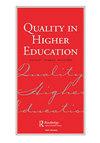高等教育质量保证培训:有效设计和成功交付的实践见解
IF 1.1
Q3 EDUCATION & EDUCATIONAL RESEARCH
引用次数: 4
摘要
摘要:本文从实践经验出发,概述了在制定高等教育质量保证培训计划时应考虑的关键方面,并提出了成功实施培训的可能措施。以实践为基础的专业反思被系统化地纳入一个适用的、经过适当测试的质量保证培训模式,该模式可以转移并适应不同的国家和国际环境。两种培训类型之间的区别指导了分析,并允许关于上下文、内容、交付和预期结果的不同结论。针对指定的质量保证专业人员的高级质量保证专业发展培训与针对其他利益相关者群体(如学者、管理人员或学生)的初始质量保证能力建设进行了比较和对比。主要目的是确定培训设计和交付的基本原则,以确保与个人培训需求相关的积极体验,并确定持久的专业影响。本文章由计算机程序翻译,如有差异,请以英文原文为准。
Training for quality assurance in higher education: practical insights for effective design and successful delivery
Abstract Derived from practical experience, this article outlines key aspects to be considered when developing a training programme focused on quality assurance in higher education and suggests possible measures of success for training delivery. Practice-based professional reflections are systematised into an applicable, duly tested, quality assurance training model that can be transferred and adapted for diverse national and international contexts. The distinction between two training types guides the analysis and allows for differentiated conclusions regarding context, content, delivery and anticipated outcomes. Advanced quality assurance professional development training for appointed quality assurance professionals is compared and contrasted to initial quality assurance capacity building for other stakeholder groups, such as academics, administrators or students. The main aim is to determine underlying principles for training design and delivery to ensure a positive experience that relevantly responds to individual training needs and determines a lasting professional impact.
求助全文
通过发布文献求助,成功后即可免费获取论文全文。
去求助
来源期刊

Quality in Higher Education
EDUCATION & EDUCATIONAL RESEARCH-
CiteScore
3.30
自引率
14.30%
发文量
32
期刊介绍:
Quality in Higher Education is aimed at those interested in the theory, practice and policies relating to the control, management and improvement of quality in higher education. The journal is receptive to critical, phenomenological as well as positivistic studies. The journal would like to publish more studies that use hermeneutic, semiotic, ethnographic or dialectical research as well as the more traditional studies based on quantitative surveys and in-depth interviews and focus groups. Papers that have empirical research content are particularly welcome. The editor especially wishes to encourage papers on: reported research results, especially where these assess the impact of quality assurance systems, procedures and methodologies; theoretical analyses of quality and quality initiatives in higher education; comparative evaluation and international aspects of practice and policy with a view to identifying transportable methods, systems and good practice; quality assurance and standards monitoring of transnational higher education; the nature and impact and student feedback; improvements in learning and teaching that impact on quality and standards; links between quality assurance and employability; evaluations of the impact of quality procedures at national level, backed up by research evidence.
 求助内容:
求助内容: 应助结果提醒方式:
应助结果提醒方式:


